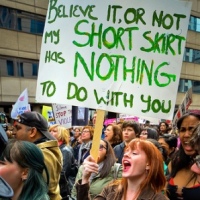 This extended stay in the city has brought me into much closer proximity with many more human beings than is normally the case, living as I do in a tiny village in a rainforest girt by sea and the mighty Clarence river.
This extended stay in the city has brought me into much closer proximity with many more human beings than is normally the case, living as I do in a tiny village in a rainforest girt by sea and the mighty Clarence river.
Even living at Bondi Beach doesn’t do as much as one might imagine to relieve the constant pressure of humanity and its leavings, given the domination of buildings and people overwhelming the landscape, but even so I’d rather be here than inland.
Sometimes at home, sitting in my feckin Swedish chair in my peaceful work room from which at night I can hear the sea, I wondered if the entire sexualisation of women and girls moral panic might be passing me by, simply because I didn’t see enough. I was protected from intrusive advertising in public spaces, and most of all, from the observation of women and girls in great numbers going about their daily lives dressed as they saw fit.
Perhaps it’s because Bondi, but there’s a lot of very tiny very tight shorts about. What I think when I see them is oh my gods, that must hurt you are cutting off the blood supply your lady bits will atrophy what about thrush there’s no air in there doesn’t it chafe when you move…and then I remember in my twenties and thirties lying flat on my back on my bed so I could zip up jeans that sat just as snugly. I remember wearing very short skirts and midriff tops even in a London winter. I remember a period of shoe fetish when I teetered about on stilettos holding babies, a practice that ought to be forbidden for the babies’ sakes. It was fun. It was costuming. But it wasn’t “sexualising.” “Sexualising” was what was done to me as a child through sexual abuse. There is a world of difference.
There’s a good piece on what sexualisation is and isn’t here by Ray at the Novel Activist blog.
Young women in revealing clothing are not “sexualising” themselves. They may indeed wish to look sexy. Whether they succeed or not is entirely in the eye of the beholder but the desire to look sexually attractive is perfectly normal for a young woman. How she performs her sexual power is largely dictated by the dominant social customs of the day, and I don’t think those customs have changed dramatically in the last few decades. They remain as restricted and unimaginative as ever.
To the moral campaigners a display of flesh signifies their concept of a prostitute, and to them, there’s little worse than a prostitute. They fail to see that displaying flesh is not automatically offering that flesh for sale or use, and in their failure, they mimic the consciousness of rapists and sexual abusers. Healthy people don’t assume that a young girl wearing short shorts is offering herself for sex. Healthy people know there’s a good deal more involved in navigating a sexual encounter than mere apparel, and they know that mutual and agreement are the key words, no matter what a woman is wearing.
What the moral campaigners want is that women take responsibility for controlling male sexual desire by not provoking it with our flesh. They’d be more useful if instead they put their considerable energies to work in campaigns that focus on educating boys to become men who take responsibility for their own sexual desires, and how they enact and gratify them.
If it is true that young women feel obliged to sexually service young men to a degree previously unheard of, then surely we need to be better educating our boys in sexual manners, rather than wringing our hands about our girls’ short shorts.
Sex is everywhere and why that should surprise anyone I don’t know. It is a powerful, dominating human force. Of course it is everywhere. Of course the majority of humanity is interested in sex. Of course sex sells. Of course women and men want to be sexually attractive. I mean, get over it.
In my utopia we’d be educating girls and boys about sex at school and at home as soon as they showed an interest. We’d be preparing them for the overwhelming nature of sexual feelings and emotions. We’d be accepting the role sex plays in our own lives and passing that acceptance on to our young, and we’d be doing it without guilt and shame.
Covering the female body is not going to achieve a thing. The campaigners are very noisily barking up the wrong tree, and from what I can see around me, nobody much is listening to them.






































Recent Comments